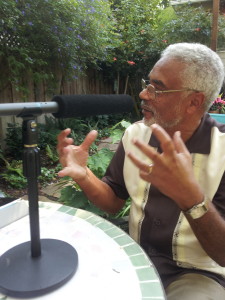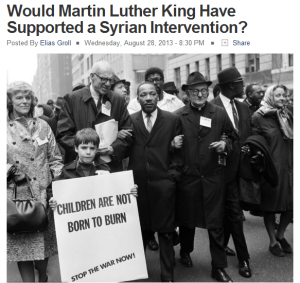Nonviolence Currents – Bridging Nonviolence and Current Events in the Classroom
A service of the Metta Center for Nonviolence
LESSON PLAN #9
This is a three-part lesson that combines the teachings of Martin Luther King, in light of the recent 50th anniversary celebration of the March on Washington, and the current crisis in Syria.
Themes: Organizing, human rights, March on Washington, Martin Luther King, Jr., Syria
Ages: Ages 15 & up
Subject areas: History, Civics, Government, Political Science
Part 1: King’s Dream
Waging Nonviolent article: A movement without a beginning or end – a conversation with Clayborne Carson
Author: Kazu Haga
Pre-reading activity: Watch the I Have a Dream speech in its entirety. Also consider doing a preliminary lesson on the March on Washington.
Reading: Have students read the interview with Clayborne Carson on Waging Nonviolence. Set aside time in class to read the article (10-15 minutes) or assign the reading for homework the night before class.
Post-reading discussion:
-
After reading King’s “Dream” speech, have students put into their own words the elements that make up his “dream.” (Make sure to emphasize more than than what the mass-media portrays about this speech.)
-
In what ways do you think that society has come closer to realizing King’s dream, and where is there work still to be done?
-
Dr. Carson says that “any kind of freedom struggle is first of all an act of imagination. You envision a different future, then try to convince other people that that future is worth struggling for.” What is the different future that you envision? How could you convince other people that this future is worth struggling for? Have students either write a convincing essay about their vision of the future, or have them give a speech about their vision.
Follow-up activity: Watch the film Brother Outsider about Bayard Rustin.

Part 2: Understanding the Legacy of Dr. King
Metta Center podcast series: Understanding the Legacy of Dr. King
To further your students’ understanding of Dr. King’s legacy, listen to this podcast series from the Metta Center with Clayborne Carson.
Have students complete the listening worksheet as they listen. As a class, discuss the answers.
Part 3: King and Syria
Foreign Policy article: Would Martin Luther King have supported a Syrian intervention? – Foreign Policy (as cross-posted on Waging Nonviolence)
Author: Elias Grol
Pre-reading Activity: Classroom barometer on Syrian intervention
Get a pulse on how students are feeling about intervention in Syria. One option would be to indicate the left side of the room as being in favor of military intervention, the right side being against intervention. Then have students place themselves on the spectrum according to how they feel about the conflict (for example, if the student is strongly in favor of intervention, they would stand touching the left wall. If they are not sure, they would stand somewhere in the middle of the room. If they are against intervention, they would be touching the right wall). If you want to do this activity more anonymously, you could do a similar activity on the board, and use the board as the spectrum, have student put a mark that represents where they are on the spectrum.
Reading: Set aside time in class to read the article (10-15 minutes) or assign the reading for homework the night before class.
Post-reading discussion:
-
Compare what Dr. Carson’s account of how King became an anti-war activist to the Foreign Policy article’s account. What differences do you notice?
-
The article does not fully answer the question of what King would support. Given what you know about Dr. King, what do you think he would say about the situation in Syria? What course of action would he have supported?
Consider using some quotes from King, such as the ones featured on the King Memorial in Washington, DC (you can find a full list of the quotes on Wikipedia):
“I oppose the war in Vietnam because I love America. I speak out against it not in anger but with anxiety and sorrow in my heart, and above all with a passionate desire to see our beloved country stand as a moral example of the world.”“Darkness cannot drive out darkness, only light can do that. Hate cannot drive out hate, only love can do that.”
“It is not enough to say ‘We must not wage war.’ It is necessary to love peace and sacrifice for it. We must concentrate not merely on the negative expulsion of war, but on the positive affirmation of peace.”
-
Have students compare President Obama’s argument for military intervention in Syria with arguments against it (see Stephen Zunes’ Eight Arguments Against Going to War in Syria and Sarah Van Gelder’s 11 Reasons Why We Should Not Attack Syria. What are the strengths and weaknesses of these arguments?
-
The main options being considered by the US government seem to be military intervention or “doing nothing.” What other options for action exist in this situation? (If students get stuck, you may want to refer to YES! Magazine’s article Six Alternatives to Military Strikes for inspiration)
- After this discussion, try the barometer activity again. See if anyone changed their position, and if so, ask them to share why.
Lesson plan created and developed by Stephanie Van Hook and Stephanie Knox Cubbon of the Metta Center for Nonviolence.
If you have any questions about this lesson, or if you use it and would like to tell us about it, please write to use at education@mettacenter.org. We would love to hear from you!









